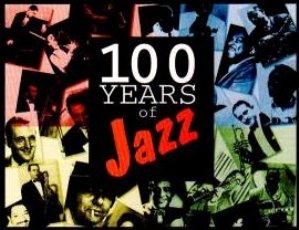100 Years of Jazz - Disc 02: New Orleans/Chicago/New York (1999)
100 Years of Jazz - Disc 02: New Orleans/Chicago/New York (1999)

1. King Oliver's Creole Jazz Band – Chimes Blues (02:54) 2. Celestin's Original Tuxedo Jazz Orchestra – Station Calls (02:53) 3. Jelly Roll Morton, Johnny Dodds, Blind Blake & Jimmy Bertrand – South Bound Rag (03:19) 4. Freddie Keppard – Salty Dog (02:47) 5. Clarence Williams’ Blue Five – Wild Cat Blues (03:02) 6. Tommy Ladnier & Lovie Austin's Blues Serenaders – Travelling Blues (02:40) 7. Louis Armstrong and His Hot Five – West End Blues (03:11) 8. Louis Armstrong & Earl Hines – Weather Bird (02:43) 9. Piron's New Orleans Orchestra – Bouncing Around (02:45) 10. Jesse Stone and His Blues Serenaders – Starvation Blues (03:20) 11. King Oliver and His Dixie Syncopators – Tin Roof Blues (02:55) 12. Jelly Roll Morton Trio – Mr. Jelly Lord (02:52) 13. Jelly Roll Morton's Red Hot Peppers – Someday Sweetheart Blues (03:31) 14. Jimmie Noone & His Orchestra – Bump It (03:23) 15. Clarence Williams and His Orchestra – Long Deep and Wide (02:56) 16. Bertha "Chippie" Hill, Shirley Clay & Artie Starks – Trouble in Mind Blues (03:10) 17. Bessie Smith, Louis Armstrong, Charlie Green & Fletcher Henderson – Careless Love Blues (03:27) 18. Jelly Roll Morton – Mamie's Blues (03:17) 19. Pinetop Smith – Pinetop's Boogie Woogie (03:21) 20. The Washingtonians – East St. Louis Toodle-Oo (03:06)
When W. C. Handy, then living in Memphis, was invited to bring a 12-piece band to New York to record for Columbia, he could find only four musicians willing to make the trip. He traveled to Chicago to fill the remaining spots, but encountered hesitancy and suspicion there, too. “Like Memphians, Chicago musicians had never heard of a colored band traveling to and from New York to make records,” he later recalled. When Freddie Keppard had a chance to make the first jazz recordings for Victor in 1916, he also expressed reservations, but for a different reason. “Nothin’ doin’ boys,” he told his bandmates. “We won’t put our stuff on records for everybody to steal.”
Meantime, jazz was taking Chicago by storm. The greatest talents in New Orleans jazz set up shop in the Windy City during the years following World War I. Sidney Bechet moved to Chicago in 1917. Jelly Roll Morton had visited Chicago in 1914 and would later return for a long stay—the city served as his home base when he made his most important recordings in the 1920s. King Oliver first found widespread acclaim as a Chicago bandleader during that same period, and Louis Armstrong first came to public attention as a member of Oliver’s ensemble, while it was performing in Chicago.
Why did jazz ever leave New Orleans? Today, that city still tries to build tourism claims around its jazz heritage, but all the boasting and brochures can’t hide the fact that New Orleans’s jazz scene has been declining for almost 100 years. In 1918, Columbia Records tried to seize the momentum of the first jazz records by sending talent scout Ralph Peer to the Big Easy in search of recording acts, but Peer shocked the home office with his telegram after three weeks on the job: NO JAZZ BANDS IN NEW ORLEANS.
That was a slight exaggeration. A few outstanding jazz players still made their homes in New Orleans. Check out the music that trumpeter Sam Morgan later recorded for Columbia, which testifies to the homegrown talent that stayed in the Crescent City. Nonetheless, the most famous jazz musicians from New Orleans had already left home by the time the public started talking about the “Jazz Age,” and the city wouldn’t come to the forefront of the idiom again until the rise of Wynton Marsalis and others in the 1980s.
The usual reason given for the departure of the first generation of New Orleans talent is the closure of the city’s red-light district in 1917. Without brothels, the story goes, jazz musicians had no place to play. The real history is more complex. True, many musicians did lose gigs as a result of the navy’s determination to clean up New Orleans, but other factors contributed to this exodus, from the influenza epidemic that ravaged the city to sheer wanderlust. But the biggest reason jazz musicians had for moving to Chicago was the simple desire to escape the institutionalized racism of the South and find better economic opportunities. A half-million African-Americans eventually relocated from Southern states to Chicago—musicians, along with everyone else.
New York also saw its black population grow during this period, but its most significant contribution to the jazz idiom in the early 1920s came mainly from local talent. The first native New York jazz style was “Harlem stride,” a rambunctious piano music. The name refers to the striding motion of the performer’s left hand, which dances back and forth from the bottom of the keyboard to the middle register on every beat, as well as to the New York neighborhood where this performance style flourished.
New York native Thomas “Fats” Waller probably did more than anyone to prove that the city didn’t always need to import its jazz talent. He was the most famous of the Harlem stride players, but a host of other brilliant keyboardists—including James P. Johnson, Willie “The Lion” Smith, Donald Lambert, Luckey Roberts, and Art Tatum—were also major contributors to the movement. With the exception of Tatum, all these musicians were born in the Northeast.
I suspect that Duke Ellington’s decision to move from Washington, D.C., to Harlem in the early 1920s—in retrospect, a turning point in jazz history—was spurred by the vibrancy of the local piano tradition. At that juncture, Chicago still would have been the favored destination for most aspiring jazz talents, but as a professional pianist immersed in the stride tradition, Ellington had different priorities. ---Ted Gioia, city-journal.org
download (mp3 @320 kbs):








